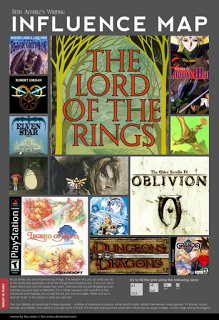I meant to finish this a lot sooner, but some things came up and for a little while, blogging was the last thing on my mind. Don’t worry, though – I’m not leaving you hanging. For anyone who was waiting, here’s the rest of the commentary on my influence map. Just in case you missed it, you can read the first part here. For sake of ease, I’ll even include the image again! Just remember, we’re starting halfway down this time.
I’m a big fan of Hayao Miyazaki’s work, but My Neighbor Totoro will likely always be my favorite. His films all share a number of qualities, ranging from artistic style to the colorful whimsy portrayed in them. But My Neighbor Totoro was the first of Miyazaki’s films I saw, and it’s stuck with me ever since. As a writer, there’s something very compelling about a story where it becomes impossible to distinguish between what the girls are imagining and what’s really happening. That immersive draw is what I strive for in my writing, and thinking of people being sucked in as they read… well, that just really tickles my fancy.
Middle, Row 4 – The Legend of Zelda
The NES version of The Legend of Zelda and I were born in the same year. I don’t remember when I first picked up the controller to give the game a try. I’ve been a gamer for essentially my entire life, and Zelda was one of my earliest video game loves. The world built in each game is innovative and immersive, and I always find myself coming back for more with each addition to the series. Until A Link to the Past was released, there wasn’t much to the storyline, but the vibrant feeling of the world was enough. Once the storytelling started to catch up with the enjoyable gameplay, I was more hooked than ever! Meeting a new version of the same hero over and over again seems like it might get stale after a while, but Zelda manages to pull off recurring characters in its storylines in a way that I, as a writer, can only refer to as artful.
Right, Row 4 and 5 – The Elder Scrolls IV: Oblivion
I’ll be honest. I didn’t think I was going to like Oblivion. I’d never played any of the Elder Scrolls games, and since all the screenshots I’d ever seen depicted first-person perspective (Which I’m TERRIBLE at playing in) I wasn’t interested in even giving it a try. My husband insisted that I ought, he ordered the game despite my protests and urged me just to give it a chance. Now, I’m glad that I did.
“I’m not interested” quickly became “I can’t believe I just played for nine hours straight!” once I stepped into the vivid world of Tamriel. I’d never encountered a game like this before – The places seemed like something straight out of my own head, the stories complicated and well-written. For heaven’s sake, there’s even books to be read inside the game. Not just any books, but mythology books! Fiction books! Multi-volume fantasy books! Books detailing the history of a rich and well-designed world that reminds me so much of my own creations that it’s almost eerie. I got swallowed up by all the creativity that went into that game, and I’m not sure I’ll ever come back out.
Left, Row 5 and 6 – Legend of Mana
The painted world of Legend of Mana is unique in that the player shapes it as they play. By completing bite-sized quests and stories, they gain artifacts that become cities, landscape or dungeons when placed on the world map. The order of the storyline can be altered by what artifacts the player chooses to place when, but it never contradicts itself, and never tells a piece of story that can’t be understood on its own. While some story aspects are simple, some are quite deep and ornate, and the ability to take a single piece of a story and make it able to stand alone is quite remarkable. This game illustrates that you don’t have to have something giant to tell a good story… and sometimes simpler is better.
Middle, Row 5 – Lunar: Silver Star Story
Dragons.
If there was nothing else that could’ve gotten me hooked on Lunar, it had dragons.
Lunar is interesting in that it takes a bunch of pop cultural references, mixes them with a bunch of cliches, and somehow gets an interesting and original story out of it. I’ve never figured out how it works, but playing through the game taught me something unusual: Sometimes it’s okay for your writing to be cliche. It’s okay to take an element of a story that’s old and worn out, and add something fresh. It’s okay for main characters to be orphans, or sons of legendary warriors. These things are often frowned upon, mostly because they’re used a lot. But they’re used a lot because they’re an old standby, something known to simply work. So go right ahead and let your hero be the chosen one! Let them fulfill an ancient prophecy! Let them actually a dragon, though they didn’t exactly know it! A good writer can take any cliche and make something interesting out of it… as long as they’re willing to try.
Middle, Bottom Row – Dungeons & Dragons
Roleplaying was a very large part of my life while I was growing up. To those aware of that, this comes as no surprise. What does tend to surprise people is that, while I’m very familiar with the lore, the monsters, the worlds and the races, I’ve never actually played D&D.; The closest I’ve come is a few mini-campaigns put together with some friends that we ended up never finishing. Half the time, we abandoned our stat sheets and dice within ten minutes, and just decided to wing it.
But many of the roleplaying games I participated in online were based on D&D.; They were freeform, which meant there were no stat sheets, no dice, and half the time, there were barely any rules. The games focused primarily on character interaction, and since it was all text-based online, it was based entirely on writing. I found my first game accidentally, but I was hooked in an instant. It was in these forums and chats that I started learning how to properly write, so even though I’ve never played, D&D; has definitely done a lot to shape my craft.
Right, Bottom Row – Grandia II
I have no idea what made me want this game, but I’ve never regretted the $15 I spent on it. Grandia II isn’t quite my usual fantasy fare – It’s blended with technology and sci-fi elements, but the way it’s done makes me still consider it wholly a fantasy game. There’s not a lot to say without spoiling the entire story, and the story is quite long – So all I’ll say is that Grandia II was an interesting look at the roles that heroes and villains usually play, and the way those roles can be twisted and skewed can make for some very interesting stories.
And with that, we are done!
My entire influence map has been spoken on. There’s other things that influence me, sure – But we’ll save those to talk about another time.

